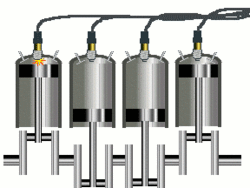Cubic centimetre

A cubic centimetre (or cubic centimeter in US English) (SI unit symbol: cm3; non-SI abbreviations: cc and ccm) is a commonly used unit of volume that extends the derived SI-unit cubic metre, and corresponds to the volume of a cube that measures 1 cm × 1 cm × 1 cm. One cubic centimetre corresponds to a volume of 1/1,000,000 of a cubic metre, or 1/1,000 of a litre, or one millilitre; thus, 1 cm3 ≡ 1 ml. The mass of one cubic centimetre of water at 3.98 °C (the temperature at which it attains its maximum density) is closely equal to one gram. Note that SI supports only the use of symbols and deprecates the use of any abbreviations for units.[1] Hence cm3 is preferred to cc or ccm.
Many scientific fields have replaced cubic centimeters with milliliters. The medical and automotive fields in the United States still use the term cubic centimetre. Much of the automotive industry outside the U.S. has switched to litres. The United Kingdom uses millilitres in preference to cubic centimetres in the medical field, but not the automotive. Most other English-speaking countries follow the UK example.
There is currently a movement within the medical field to discontinue the use of cc in prescriptions and on medical documents, as it can be misread as "00". This could cause a hundredfold overdose of medication, which could be dangerous or even lethal. In the United States, such confusion accounts for 12.6% of all errors associated with medical abbreviations.[2]

In automobile engines, "cc" refers to the total volume of its engine displacement in cubic centimetres. The displacement can be calculated using the formula
where d is engine displacement, b is the bore of the cylinders, s is length of the stroke and n is the number of cylinders.
Conversions
- 1 millilitre = 1 cm3
- 1 litre = 1000 cm3
- 1 cubic inch = 16.387 cm3.
See also
References
- ↑ International Bureau of Weights and Measures (2006), The International System of Units (SI) (PDF) (8th ed.), p. 130, ISBN 92-822-2213-6
- ↑ Brunetti, Luigi; Santell, John; Hicks, Rodney (September 2007). Stevenson, James, ed. The Impact of Abbreviations on Patient Safety (PDF). The Joint Commission Journal on Quality and Patient Safety. 33. p. 8.